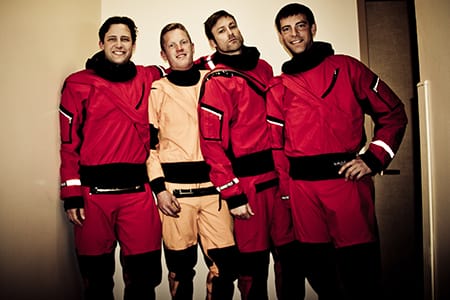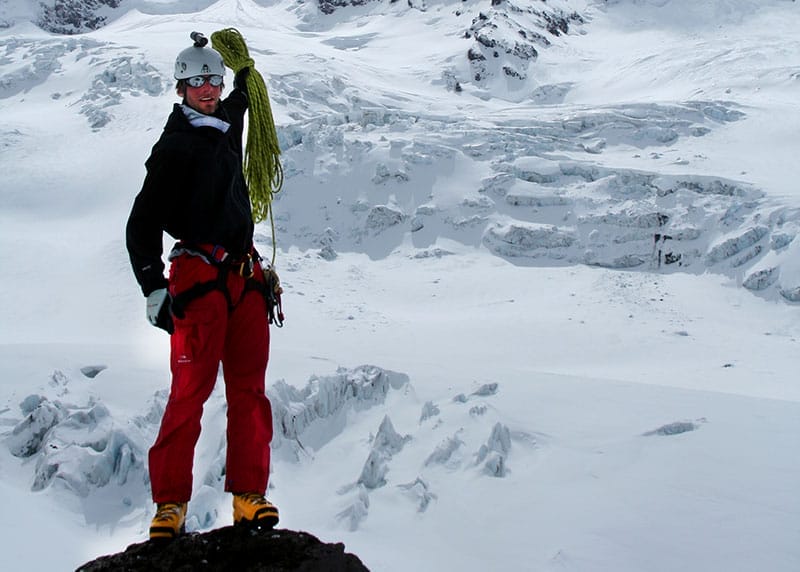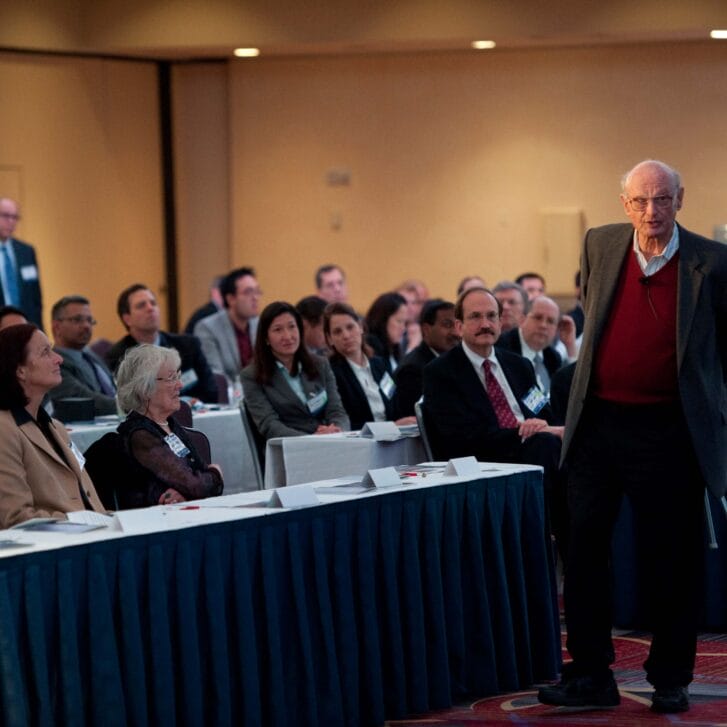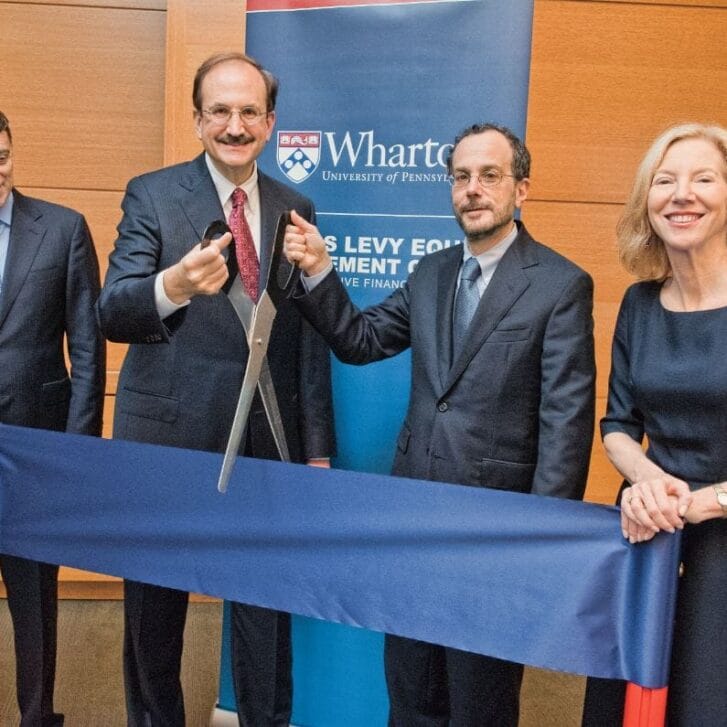In the midst of a 41-day rowing expedition in the Arctic Ocean in 2012, Neal Mueller C00 WG08 and his team accidentally found themselves encircled by a pack of icebergs the size of school buses. Rather than panicking at an obstacle that Mueller recalls as “engulfing us completely by ice,” he drew on the patience and confidence he learned at Wharton to wait for an opening.
“We were 100 miles from shore so we had to row around in place and wait for an opening [between the icebergs] to appear,” he says. After four hours, a way out did appear, and Mueller and his team were able to row far enough (1,000 miles) to make it into the Guinness Book of World Records.
Mueller, along with three other alumni we spoke with—a contestant on NBC’s hit show American Ninja Warrior, an ultramarathoner and a pioneering mountain climber—all credit Wharton for some aspect of their successful adventures.
We share their stories here.
Assets Anchored in Careful Analysis
Lei Wang’s first exposure to mountain climbing came during a retreat for her Wharton Leadership Venture program. The group planned to climb Mount Cotopaxi in Ecuador, and Wang WG03 was out of her comfort zone.
She was so unfamiliar with mountain climbing that she had to take her gear list to an outdoor store and have them help her assemble a proper pack.
“I figured I’d go one time, and that would be it,” she says of that first expedition in 2002.
However, a short time after graduation, she saw the documentary Touching the Void, a survival story about two climbers in the Andes. “I found them to be so brave and inspiring,” she says. At the time, Wang was an investment manager, but she was determined by June 2004 to complete the Seven Summits. In Aug. 2005, she took on Mount Elbrus, a dormant volcano in Russia that stands as the tallest peak in Europe. Afterward, it “became a quest” to summit the tallest mountains on each continent.
“After I had been training toward the goal, I found myself totally in love with mountains,” she recalls.
The next year, she received an invitation to climb Cerro Aconcagua, the tallest peak in South America. After failing to make the summit in 2006, she tried again in 2007 and again fell short of her goal.
Enter her Wharton analytical skills to review her climbing team’s performance.
“It was pretty obvious I was not sufficiently skilled or trained. Climbing is all about logistics, and I had chosen the wrong time of year and had the wrong level of preparation,” she says.
From then on, she used risk analysis to thoroughly evaluate her expeditions and plan “every detail meticulously,” yet always keeping in mind a delicate balance.
Before her Everest trip, Wang made detailed plans, including arrangements for who would help her make medical decisions if she were unable to decide herself and who would console her parents (who didn’t know she was on Everest until she survived). She studied what could go wrong on the mountains, made backup plans for transportation and critical gear.
“On the mountain, every move, up or down, is a constant calculation of risk, and making quick decisions is critical. Know when to go, when to stop, when to rest, when to push,” she explains.
Wang went on to summit Cerro Aconcagua (Argentina), as well as Carstensz Pyramid/Puncak Jaya (Indonesia), Mount McKinley/Denali (North America), Kilimanjaro (Africa) and Mount Vinson (Antartica). In 2010, six years since setting the goal, she carried out her final expedition to Mount Everest to complete the Seven Summits.
Wang applies what she learned on those expeditions and at Wharton to her speaking engagements around the world. She has become a sought-after lecturer focusing on helping people find what motivates them. Wang says there’s nothing wrong with ambition, “but you also have to be realistic and most of all be prepared.” She is fine with where she left the mountaineering world.
“I went much further than I ever thought with climbing, but I also know I don’t have to go to a mountain to seek adventures,” she says.
An American Media Branding Warrior
Eight years ago, when the “Ninja Warrior” franchise had yet to reach the U.S., Matt Laessig G98 WG98 was merely a superfan. At the time, he owned a bed-and-breakfast in Santa Fe and would watch the Japanese obstacle course show on cable TV. Realizing the storyline of contestants desperately trying to reach the final obstacle of Mount Midoriyama would appeal to American audiences, he bought the domain americaninjawarrior.com for $10 and began blogging about the show.
“Wharton taught me how to position myself to be an early mover in a trend,” he says. (Two seasons ago, he transferred the domain to the show under confidential terms and now blogs at www.anwblog.com.)
Not content to write on the sidelines, Laessig, who now lives in Austin, Texas, and is vice president of global business development at HomeAway, started training to be a contestant. What he learned at Wharton has been integral to his repeat appearance on the show for the past six seasons.

“I had to brand myself to stand out in the field of competitors,” he says. “I was able to identify myself as a middle-age dad and original superfan of the show.” And it worked. He first appeared on Season 2 of American Ninja Warrior on prime-time television.
Laessig maintained his branding in annual submission videos and interviews, making himself a unique juxtaposition to the young, obstacle course enthusiasts trying out for the show.
“They get 50,000 applications for 500 spots,” he says of the show’s producers. “Being an Internet entrepreneur wasn’t enough.”
Not only did his Wharton education help him get on the show, he believes, but it has also helped him stay on the show for the past six seasons for other reasons.
“I have the discipline to act on my goals,” he says.
Wharton, he says, has also helped him stay calm under the glare of the spotlight and the heat of competition.
“The adrenaline can cause you to almost black out, but I tap into my Wharton experience where I was in a high-pressure, competitive environment,” he says. He also thinks of all the high-stakes presentations he’s given to venture capitalists. “I don’t train nearly as hard as the younger guys, but I have forged the mental acuity to stay calm and focused.”
Don’t be fooled, though; he studies what skills are needed to compete based on each year’s talent pool and obstacles, and he continues to hone them. For instance, he took up rock climbing to work toward an iron grip and the movement discipline parkour to enhance his agility, activities he regularly enjoys with his sons (ages 9, 7 and 5).
American Ninja Warrior contestants compete in a series of regional rounds to qualify for the national finals. In Season 6, Laessig, 44, completed the Dallas regionals course and advanced to the regional finals, during which he fell a couple obstacles short of making the national finals. While he would love to compete in the national finals one day, Laessig says he won’t be destroyed if it doesn’t happen.
“I tell my three boys that you make your plan to be competitive, but you need to be OK with having tried your best and not won,” he says.
As for the dreaded fall into the water that befalls all but the winners on American Ninja Warrior: “Everyone falls in the water at some point on that show. It’s what you can learn about it and can apply to your next race,” he says.
Season 7 of American Ninja Warrior, featuring Laessig, is airing now. (Watch Laessig’s efforts in Season 6 in the video below.)
Discipline in the Wild
When Mueller moved to Boston after Penn undergrad, he found it hard to meet people as he had no interest in the busy bar scene. He stopped into an outdoor store for ideas of what to do on the weekends. The clerk pointed him in the direction of Mount Monadnock in New Hampshire, a few hours north of Boston, to go mountain climbing. Little did the clerk know that he set Mueller on a path of adventure.
“That first time I climbed a mountain, I got such a sense of accomplishment,” Mueller says. “I started climbing every single weekend.”
As he tackled more mountains, including ice climbing on New Hampshire’s Mount Washington, he met more people who wanted to do bigger expeditions. When his former employer stationed him in Europe for a tour of duty, he took the opportunity to chase the Seven Summits and completed them all.
Mueller then decided to tackle Mount Rainier’s challenging North Face summit, called Liberty Ridge. The ascent had been attempted often but hadn’t been completed during winter in the 19 years before Mueller’s 2006 climb. Facing untenable conditions, including deep snow, high winds and whiteouts, Mueller’s team of three mountaineers pushed through to the top.
“A mix of Midwest pride and fortitude pushed the men through the exhausting conditions,” wrote Mike Gauthier, a National Park Service fellow and climbing icon.
Two years later, Mueller graduated from Wharton.
“In many ways I was a better student because of the discipline I learned on the mountain,” he says. “But Wharton taught me how to think conceptually about team dynamics.” That skill, he says, would mature his outdoor expeditions.



Highlights from before and during Neal Mueller’s historic 1,000-mile row across the Arctic Ocean.
Post-Wharton, Mueller was able to analyze every aspect of an expedition and determine what went right and wrong. “I could then have a formula to repeat the successes and avoid the failures,” he says.
Mueller’s list of accomplishments is long, including a 2005 trek up Mount Everest and a swim across the English Channel in 2008, a month after his Wharton graduation.
The most complicated expedition he’s ever embarked on, and the one that landed him in the Guinness Book of World Records, was his aforementioned 2012 Arctic Ocean row. It was this adventure, he says, that drew most from his time at Wharton.
“Expeditions involve fundraising, recruiting, building a position in the market that is unique and defensible, and executing a plan,” he says. “The Arctic row required this and more because it was like doing a startup in a new marketplace.”
Over 41 days, Mueller and his three teammates rowed 1,000 miles in the Arctic Ocean. Their $100,000 fundraising came from crowdsourcing on Indiegogo and Kickstarter. Mueller validated the expedition by speaking about his plans. He gathered 1,000 questions from people and answered them all. He integrated data from disparate information sources because no central repository, or guidebook, existed for the last remaining unrowed ocean.
“It had never been done, so we had to define and forge a new route. We had to define the requisite gear, safety protocols, sleep/wake schedule, retrofit warm water rowing gear for the cold and figure out a safe route,” he explains.
“Arctic row was about the unknown,” he says, adding that the Wharton skill of regression analysis turned out useful to build predictive models for ocean currents, Arctic wind, Arctic sea ice extent and melt, and plankton tracking.
Once on the water, his Wharton experience helped him out of some dicey moments, like that time he was surrounded by school bus-sized icebergs 100 miles from shore. In the most dangerous moments, it’s your instinctive brain that helps the most, according to Mueller.
“Fear of failure is a great motivator. Every time you succeed, it conquers failure,” he adds.
(Success is a great motivator too. See why in the short video below, taken by Mueller on the top of Mount Everest.)
Motivated Beyond Ultra Perseverance
In 1980, shortly after Denise Green Winner W83 joined Penn’s cross-country team, she ran her first marathon. Women were just gaining a foothold in running, let alone distance races. After all, the first Olympics to feature a woman’s marathon wasn’t until 1984.
Winner “toed the line” at the start of her first marathon, the Penn Relays marathon in Philadelphia, without having trained the distance. She finished the 26.2-mile course with an astonishing time of 3 hours, 8 minutes. It was then that she decided to dedicate her running efforts to marathons.

Winner already had conquered shorter distances but found herself losing the speed needed to succeed at more competitive levels. Marathons seemed a perfect fit for her talent and endurance. So she continued her streak, running the 1981 New York City Marathon in 2 hours, 50 minutes, and the 1982 Boston Marathon in 3 hours, 4 minutes. After graduating Wharton in 1983, Winner moved to Chicago and began her financial engineering career, but she continued to train in the bitter cold and run marathons around the world and even qualified for the Olympic trials in 1984.
In 1986, she decided to step her goals up a notch and completed the American Medical Joggers Association’s 50-mile ultramarathon in 6 hours, 38 minutes, ranking her the fifth fastest in the world for that distance. She went on to complete seven more ultra competitions, winning five.
Winner says Wharton had a large role in moving her toward ultramarathons. “At Wharton, I learned the power of risk management and forecasting and applied these skills to further my running career,” says Winner. Early on, she realized, her return on shorter distances was diminishing and that longer distances would garner her greater reward for the effort.
“I managed my progress by tracking mileage, pace, results per race and qualitative issues too (state of mind, fatigue). In the 1980s and 90s, there were no apps or smart watches,” she explains. “Originally, I charted my progress; later, I logged results in a spreadsheet to best analyze the trade-off between speed and distance and better predict race outcomes. Given I ran races regularly and had a training regimen, I had a reasonable amount of data to analyze and forecast results.”
What she wasn’t able to forecast was the impact of lupus, an autoimmune disease she was diagnosed with in the 1990s. Winner decided to run a 50-miler to raise money for the disease but found it difficult to get backing. “In the ’90s, they believed lupus was best treated with bed rest, so no one wanted to sponsor my running,” she says. She dug into the marketing skills she gained at Wharton to package herself and the importance of exercise for autoimmune patients and eventually found supporters. She completed 28 miles of the 50-miler, placing first for the marathon portion of the race.

Winner’s move to sunny California in 1989 precipitated lupus complications, stopping her from realizing her competitive dreams. To stay active, she continued to train regularly and hoped to compete again. She launched ultra teams to compete in the 200-mile point-to-point relay runs called Ragnar Relays. In 2012 and 2013, she and her team of five placed first in the ultramen’s division.
Starting to feel on the mend, Winner tested the waters of masters racing for women over 50. She trained and ran a halfmarathon in Israel finishing with a gold. A month later, she went out hard in an inaugural local half marathon. Within the first 3 miles, she tore her hamstring but still finished in 1 hour, 50 minutes, a fast pace even for runners without an injury.
“After surgery, I had time to regroup and decided I really wanted to do something combining my passions for running and philanthropy for this next part of my life,” she says.
She developed a concept for a series of runs where fun and fitness intersect. In the fall of 2014, Winner launched Conquer Our Run. Each race designates a charity (starting with Lupus LA) for which the event heightens awareness and Motivated Beyond Ultra Perseverance raises funds. Winner also is working on developing a new technology, based on Bluetooth, to time races.
“As a Wharton graduate, you know if you can market an idea well, manage the P&L and do it with passion, success will follow,” she says.
—Sandra Gittlen is a freelance business, lifestyle and technology writer in the greater Boston area.

























